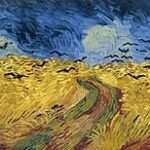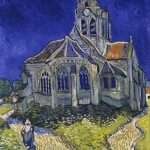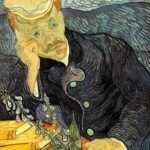|The renowned Dutch painter at Auvers-sur-Oise|
Van Gogh at Auvers-sur-Oise is an extraordinary period in the life and artistic journey of the renowned Dutch painter. During the final days of his life, Vincent van Gogh resided in the idyllic village of Auvers-sur-Oise, located just outside of Paris, France. This picturesque setting inspired him to create some of his most remarkable and emotionally charged artworks. In this article, we will delve into Van Gogh’s time in Auvers-sur-Oise, exploring the significance of this period and the impact it had on his artistry.
Van Gogh the foundations of modern art
Vincent Willem van Gogh (30 March 1853 – 29 July 1890) was a Dutch Post-Impressionist painter who posthumously became one of the most famous and influential figures in Western art history. In a decade, he created about 2,100 artworks, including around 860 oil paintings, most of which date from the last two years of his life. They include landscapes, still lifes, portraits and self-portraits, and are characterised by bold colours and dramatic, impulsive and expressive brushwork that contributed to the foundations of modern art. Not commercially successful in his career, he struggled with severe depression and poverty, which eventually led to his suicide at age thirty-seven.
Vincent van Gogh’s Last Days in Auvers
Vincent van Gogh was a prolific painter known for his expressive style and vivid use of color. Despite his artistic brilliance, Van Gogh faced numerous personal struggles and battles with mental health. As his life neared its end, he sought refuge in the quiet village of Auvers-sur-Oise, hoping to find solace and inspiration in its natural beauty.
Arrival in Auvers-sur-Oise
In May 1890, Van Gogh arrived in Auvers-sur-Oise under the care of Dr. Paul Gachet, a physician who specialized in treating mental health disorders. The peaceful countryside and charming architecture of the village provided a stark contrast to the bustling city life Van Gogh had experienced in Paris. Here, he could immerse himself in the tranquility of nature and focus on his art.
The Serene Landscape of Auvers-sur-Oise
Auvers-sur-Oise is blessed with breathtaking landscapes that captivated Van Gogh’s imagination. Rolling hills, wheat fields, and meandering rivers offered him endless subjects to paint. The play of light and shadow across the vast open spaces became a prominent feature in his works. Van Gogh’s fascination with the changing seasons and the interplay between nature and man is evident in his paintings of the village.
A Burst of Color: Van Gogh’s Artistic Style
Van Gogh’s time in Auvers-sur-Oise marked a significant shift in his artistic style. Influenced by the vibrant hues of the natural surroundings, he experimented with bold colors and dynamic brushstrokes. His works from this period exhibit a heightened intensity and emotional depth, capturing the essence of his inner turmoil and his profound connection with nature.
Deepening Despair: Van Gogh’s Mental State
While Van Gogh found solace in the beauty of Auvers-sur-Oise, his mental state continued to deteriorate. The burden of his mental illness weighed heavily on him, and his paintings began to reflect his inner struggles. Through his art, he conveyed his emotions and attempted to make sense of the chaos within his mind.
The People of Auvers-sur-Oise
During his time in Auvers-sur-Oise, Van Gogh formed relationships with several individuals in the village. Dr. Gachet, who treated him, became a friend and subject of his paintings. Van Gogh also painted portraits of other villagers, capturing their unique personalities and the essence of rural life. These interactions provided him with a sense of community and offered respite from his inner turmoil.
Van Gogh’s Artistic Output in Auvers-sur-Oise
The period in Auvers-sur-Oise was incredibly productive for Van Gogh. Despite battling personal demons, he produced an astonishing number of artworks during his short stay. His paintings portrayed landscapes, portraits, still life, and scenes of village life. Some notable pieces from this period include “Wheatfield with Crows,” “The Church at Auvers,” and “Portrait of Dr. Gachet.”



Legacy and Recognition
Unfortunately, Van Gogh’s brilliance was not widely recognized during his lifetime. It was only after his tragic death that his artworks gained significant acclaim and appreciation. Today, Van Gogh is celebrated as one of the greatest artists in history, and his time in Auvers-sur-Oise is recognized as a profound and impactful chapter in his artistic journey.
FAQs
- How long did Van Gogh stay in Auvers-sur-Oise?
Van Gogh stayed in Auvers-sur-Oise for approximately two months, from May to July 1890.
- Did Van Gogh sell any paintings during his time in Auvers-sur-Oise?
Van Gogh sold only one painting during his time in Auvers-sur-Oise, “The Red Vineyard,” to Anna Boch.
- What was Van Gogh’s mental condition during his stay in Auvers-sur-Oise?
Van Gogh’s mental condition continued to decline during his stay in Auvers-sur-Oise, leading to moments of great despair.
- Are Van Gogh’s artworks from Auvers-sur-Oise on display today?
Yes, many of Van Gogh’s artworks from his time in Auvers-sur-Oise are on display in museums and galleries worldwide.
- How did Van Gogh’s time in Auvers-sur-Oise influence his art?
Van Gogh’s time in Auvers-sur-Oise influenced his art by infusing it with vibrant colors, emotional intensity, and a deeper connection to nature.
Van Gogh’s stay in Auvers-sur-Oise was a bittersweet chapter in his life. The serene landscapes, vibrant colors, and close-knit community offered him temporary solace from his inner turmoil. Through his artworks, Van Gogh immortalized the beauty of Auvers-sur-Oise and shared his unique perspective with the world. Join us for a private tour with private driver to Vincent van Gogh in Auvers.
Emy,

